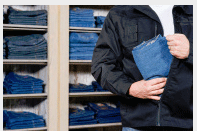 According to the Small Business Administration (SBA), there are more than 28 million small businesses in the United States and they account for more than 99% of businesses in the country. Small businesses employ close to 57 million people in the United States alone and are a driving force in the progress of the US economy. The good news for an entrepreneur that wants to start a business is that they are not alone, but if you are a small business in the retail industry, the problems you will encounter do not come as paperwork filings or taxes paid. Shoplifting and employee theft are two of the major causes small retail shops face financial distress during their business enterprise. It is an unfortunate problem, but the problem is there and the small business owner has to find solutions to the specific problems in their store.
According to the Small Business Administration (SBA), there are more than 28 million small businesses in the United States and they account for more than 99% of businesses in the country. Small businesses employ close to 57 million people in the United States alone and are a driving force in the progress of the US economy. The good news for an entrepreneur that wants to start a business is that they are not alone, but if you are a small business in the retail industry, the problems you will encounter do not come as paperwork filings or taxes paid. Shoplifting and employee theft are two of the major causes small retail shops face financial distress during their business enterprise. It is an unfortunate problem, but the problem is there and the small business owner has to find solutions to the specific problems in their store.
For more about this and other types of stories, follow the links below.
Retailers ‘tagging’ meat to prevent shoplifting
First it was clothes‚ then electronic goods and baby formula. Now it is meat.
Retailers waging a battle against grocery store shoplifting are adopting unorthodox crime prevention measures by placing electronic security tags on expensive cuts of meat.
The food tags work in the same way as on items such as clothes. Exit the shop without paying for the chunk of steak and an alarm goes off.
Sowetan observed a packer gingerly placing the strange tags on meat this week at one retail chain store west of Johannesburg.
The drastic measure is apparently a direct response to a rise in shoplifting of unconventional goods like meat in tough economic times. In the past‚ tagging was reserved for goods like CDs.
Last week Sowetan reported that a Kliptown policewoman was caught shoplifting meat worth R620 at a Pick n Pay store in Lenasia. She has been released on R500 bail.
Retailers offered top five tips to stop shoplifters
More than 360,000 shoplifting offences were reported in the UK in 2016-17 financial year, according new research.
The data from online marketplace OnBuy.com revealed that the Metropolitan Police had the highest number of shoplifting offences reported in the 12 month period at 47,580 – the equivalent of 130 incidents a day. The Met was closely followed by West Midlands Police, who had 19,741 incidences of shoplifting reported, followed by Greater Manchester Police with 18,002 shoplifting offences.
Meanwhile, City of London Police had the lowest number of shoplifting cases, with only 729 reported – the equivalent of two occurrences every day.
Cas Paton, managing director of OnBuy.com, said: “Shoplifting is more prevalent than we would like to think. Considering the amount of time and energy shops put into running various aspects of their operation daily, shoplifting is really an unfortunate occurrence for them.
Shoplifting: How to prevent ‘blind spots’ in the store layout
Though many types of theft deterrent equipment exist, one of the most effective and affordable approaches is preventing retail shoplifting is by avoiding “blind spots” in the store layout.
In this regard, one of the hardest places for supermarket or mass merchandise cashiers to control and easily view has been under the shopping basket, which is usually blocked by a basketful of other items above it. Failing to ring up items under the basket before customers leave the store can be extremely costly to retailers.
To prevent such losses, one nationally recognized mass-market retailer has already installed over 90,000 bottom-of-the basket (BOB) mirrors in an effort to limit this type of shrinkage in their business. The inventive mirrors are comprised of lightweight acrylic and the mirror mounts opposite the standing cashier to provide a clear, unobstructed view of the bottom of the cart without requiring the cashier to move or stoop, which also expedites checkout.
 It might be too early for retailers to prepare for the holiday season, but it is never too early to implement security measures to prevent shoplifting in their stores. The holiday season attracts more customers than at any other time of the year, therefore shoplifting incidents increase with the increase of customers as well.
It might be too early for retailers to prepare for the holiday season, but it is never too early to implement security measures to prevent shoplifting in their stores. The holiday season attracts more customers than at any other time of the year, therefore shoplifting incidents increase with the increase of customers as well. Are you a small business owner dealing with the security of your store? Are you tired of not knowing where the losses are coming from? Employee theft and shoplifting are two of the major losses retail stores across the United States face every day. The millions of dollars the retail industry loses every day are due to employee theft and shoplifting, so how do you prepare yourself from employee theft? Employee background checks can be a first step in dealing with employee theft. Paying for background checks for your employees is investing in the future of your store. Training them and going through the hiring process takes time and money. By hiring the right people the first time, you save time and money that can be spent elsewhere.
Are you a small business owner dealing with the security of your store? Are you tired of not knowing where the losses are coming from? Employee theft and shoplifting are two of the major losses retail stores across the United States face every day. The millions of dollars the retail industry loses every day are due to employee theft and shoplifting, so how do you prepare yourself from employee theft? Employee background checks can be a first step in dealing with employee theft. Paying for background checks for your employees is investing in the future of your store. Training them and going through the hiring process takes time and money. By hiring the right people the first time, you save time and money that can be spent elsewhere.

 Addiction is a big factor is some shoplifters’s lives.
Addiction is a big factor is some shoplifters’s lives.

 The retail industry is facing many challenges.
The retail industry is facing many challenges.